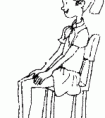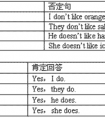用所给单词的正确形式填空。1.TodayisFebruary _________ (fifteen).2.I_________(eat)theicecreamyesterday.3. Iwanted_________ (fly)akite,butit _________ (be)too-五年级英语
题文
| 用所给单词的正确形式填空。 |
| 1. Today is February _________ (fifteen). 2. I _________ (eat) the ice cream yesterday. 3. I wanted _________ (fly) a kite, but it _________ (be) too hard. 4. I hurt _________ (I) arm and Jenny helped _________ (I). 5. You were _________ (sleep) on the train. |
答案
| 1. fifteenth 2. ate 3. to fly, was 4. my, me 5. sleeping |
据专家权威分析,试题“用所给单词的正确形式填空。1.TodayisFebruary _________ (fift..”主要考查你对 一般过去时,动词过去式,序数词,人称代词,物主代词,系动词 等考点的理解。关于这些考点的“档案”如下:
一般过去时,动词过去式序数词人称代词物主代词系动词
考点名称:一般过去时,动词过去式
一般过去时:
表示过去某个时间里发生的动作或状态;过去习惯性、经常性的动作、行为;过去主语所具备的能力和性格。
be动词在第一人称是单数和第三人称是单数是用was,其余用were。
a. 表示在过去时间里所发生的动作或存在的状态,常与表示过去的时间状语。
yesterday(昨天)、last week (上星期)、an hour ago(一小时前)等连用。
例:I went to the zoo with my father last Sunday. 上周日我和我爸爸去动物园了。
They weren't able to come because they were so busy.他太忙了,所以去不了。
b. 表示在过去一段时间里,经常性或习惯性的动作或状态。
例:My brother watched the World Cup every day last month.上个月哥哥每天都看世界杯比赛。- 一般过去时句法结构:
肯定形式
主语+动词过去式+其他
例句:She often came to help us in those days.
否定形式
①was/were+not;②在行为动词前加didn't,同时还原行为动词
例句:I didn't know you like coffee
一般疑问句
①Did+主语+do+其他? ②Was\Were+主语+表语?
例句:Did I do that?
用表格整理如下:肯定式 疑问式 否定式 疑问否定式 Iworked Did I work? I did not work Did I not work? He(She,It) worked Did he(she,it) work? He(she,it) did not work Did he(she,it) notwork? We worked Did we work? We did not work Did we not work? You worked Did you work? You did not work Did you not work? They worked Did they work? They did not work Did they not work?
结构句型:
1.一般句子
I watched TV last night.
2.一般疑问句
Did you watch TV last night?
3.there be 句型
There was an apple on the table last night.
Was there an apple on the table last night - 一般过去时用法口诀:
一般过去时并不难,过去动作、状态记心间。
动词要用过去式,时间状语句末站。
否定句很简单,didn't 站在动原前,其它部分不要变。
一般疑问句也好变,did放在句子前,主语、动原、其它部分依次站。
特殊疑问句也简单,疑问词加一般疑问句记心间。
最后一条请注意,动词过去式要牢记! - 过去式和过去分词的构成表:
不规则变化的动词过去式:词
构成
举例
一般情况
词尾+ed
动词原形
过去式和过去分词
look
talklooked
talked以不发音字母e结尾
词尾+d
like
arriveliked
arrived以“辅以字母+y”结尾
变y为i,再加ed
fly
studyflied
studied以重读闭音节结尾,且末尾只有一个辅音字母
双写词尾+ed
stop
planstopped
planned
have---had are---were get---got say---said feel---felt do/does---did is---was go---went drink--drank eat--ate bring----brought think----thought
buy----bought catch---- caught teach ---- taught sit----sat wear----wore cut----cut sweep----swept sleep——slept become----became
考点名称:序数词
- 序数词:
即表示顺序的数词。
A、1-3的序数词。 第1 first 第2 second 第3 third
B、4-19的序数词的表示方法,是由“基数词+ th”构成。
如:第4 fourth 第5 fifth 第8 eighth 第18eighteenth
C、20-100的序数词的表示方法。
a. 整数的表示方法,是把整数基数词的词尾“y”改写成“i”,然后加-eth,如:第20 twentieth 30 thirtieth
b. “百”的序数词的表示方法是在hundred词尾直接加“-th”如:第100 a hundredth
c. 其他两位数序数词的表示方法:由基数词变化而来,十位数不变,个位数上的基数词变成序数词,中间用连字符“-”连接。如:第21 twenty-first 第52 fifty-second - 序数词的缩写:
有时,序数词可以用缩写形式来表示。主要缩写形式有。
first—lst
second—2nd
third—3rd
fourth—4th
sixth—6th
twentieth—20th
twenty-third——23rd
其中lst,2nd,3rd为特殊形式,其它的都是阿拉伯数字后加上th。 - 基数词变序数词方法口诀:

![Yesterdayhe hiskeys,sohecan'tgohome.[ ]A. losedB. lostC. losesD. losted-六年级英语](http://www.00-edu.com/d/file/ks/4/1/51/2019-08-24/small56b740c860ea72171119a747c83813f51566588119.gif)

![I ____________ to the store on Sunday. [ ]A. goB. went-五年级英语](http://www.00-edu.com/d/file/ks/4/1/51/2019-08-24/smallb5041caaeb2961272b3d1491492e45251566588603.gif)


